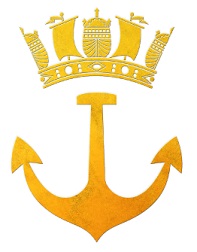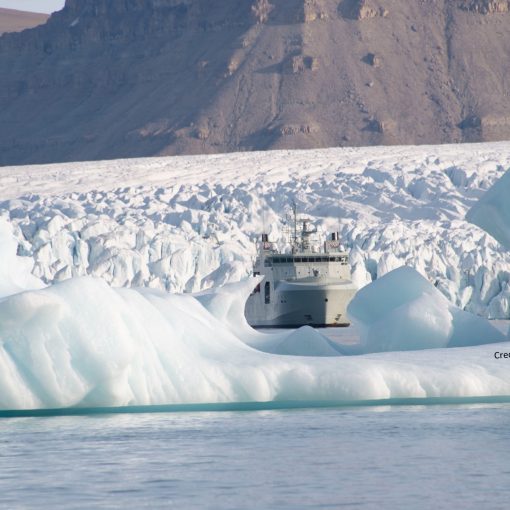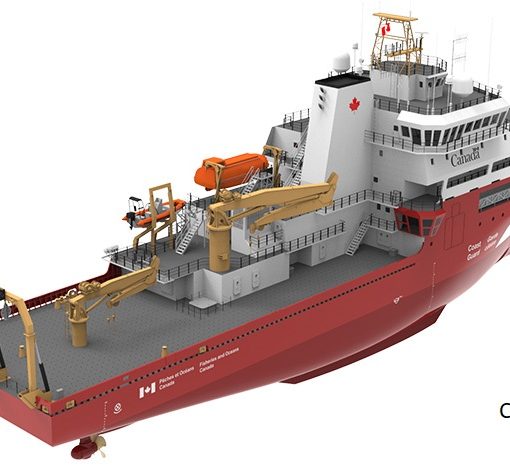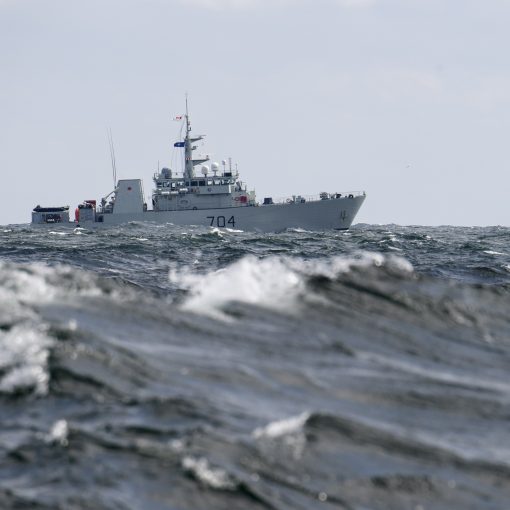By Dave Perry, 22 November 2025
[This is an excerpt of an article in Vol. 21, No. 2 of Canadian Naval Review. For the full article, click on the link below.]
During the 2025 federal election the Liberal Party of Canada committed to giving the Canadian Coast Guard (CCG) a more meaningful role in Canada’s national security. Specifically, the party platform promised to “expand the reach and abilities of the Canadian Coast Guard and integrate them into our NATO defence capabilities.”1 At the time of writing, the complete implications of the move remain to be fully fleshed out. Prime Minister Mark Carney’s government has, however, already moved the organization to sit under a new department, as it is now operating as a Special Operating Agency under the Department of National Defence (DND). Further, senior CCG leadership began participating in DND governance meetings over the summer of 2025.
These swift initial moves, without waiting on a fully specified revised mandate, represent timely, much-needed and long-overdue reorientation of the organization’s role and mandate. As one former senior CCG official noted, given the unique role for the organization, it has always been a bit of an orphan in the federal government, as its mix of transportation safety, scientific and security activity left it an uneasy fit under the Department of Fishery and Oceans. While the CCG may still be somewhat of an orphan, clearer direction on its national security role and having it report to the Department of National Defence may ensure it now has a better foster home.
Since the publication of the 2004 National Security Policy, the Canadian Coast Guard has operated with a vaguely defined national security mandate and little guidance as to how it could meaningfully contribute to the actual guarding of Canada’s coasts. The CCG was identified as one of the organizations (alongside the Canadian Armed Forces and RCMP) tasked with providing enhanced marine security through a six-point plan that included increased on-water presence, better coordinated action with Canadian and American partners, enhanced secure communications, and establishing a Marine Security Operation Centre.2 Aside from this, the organization lacked formal direction on how it might be a more meaningful security partner, a situation exacerbated by a lack of funds to recapitalize its aging fleet until the creation of the National Shipbuilding Procurement Strategy in 2010 under the Stephen Harper government, and the expansion of CCG fleet plans under Prime Minster Justin Trudeau.
Nonetheless, albeit aged, the CCG still possesses the largest number of Canadian assets on the water and, through its fleet of icebreakers, the only government vessels capable of transiting some Canadian waters during ice season. This practical on-water presence therefore presented a meaningful opportunity to make a significant improvement to Canada’s marine security posture by changing the organization’s mandate and providing it with the supporting equipment to deliver on it. In recent years there were calls for exactly this type of change to both role and equipment, which could relatively quickly make a significant enhancement to Canadian operational maritime capability.3
This discussion took on a new tone in private conversations in Ottawa as 2024 approached. This is the year by which all NATO allies pledged at the 2014 Wales Summit to reach the NATO investment target of spending 2% of Gross Domestic Product (GDP) on defence. As the deadline and the alliance’s 75th anniversary beckoned, Canada remained nowhere close to the target, and moving the CCG under the purview of the Minister of National Defence was viewed by some as a means of reaching the NATO benchmark. Indeed, Prime Minister Trudeau himself made this suggestion while defending his decision to make only a verbal commitment to reaching the 2% of GDP mark by 2030, after publishing a new defence policy that committed to reach the 1.76% spending mark during a press conference at the very end of the 2025 NATO Summit in Washington. Canada was focused only on making meaningful defence investments, he claimed, and he was not prepared to hit an arbitrary target by undertaking accounting tricks “or giv[ing] every Coast Guard member a handgun.”4 Trudeau’s comment was at once wrong mathematically and substantively. Mathematically, adding every dollar of the roughly $2 billion a year in spending on the CCG would not have remotely closed the gap to Canada spending 2% of GDP on defence. Substantively, giving every CCG member a pistol would not on its own have made each dollar count towards the NATO expenditure target, as under the commonly agreed NATO formula to determine spending eligibility, simply equipping members with a sidearm would not have met the definition for defence expenditures.
…..
To read the rest of the article, go to https://www.navalreview.ca/wp-content/uploads/public/vol21num2/cnr_vol21_2_Perry.pdf






One thought on “Dollars and Sense: Giving the Canadian Coast Guard a Larger National Security Role”
If the Coast Guard truly shifts under the Department of National Defence, we shouldn’t underestimate how significant a cultural, organizational, and identity change this will be for a civilian service that has spent its entire modern existence under Fisheries & Oceans. The Canadian Coast Guard is not the Navy. Its people did not join to become military personnel, they have no role in armed conflict, and their institutional DNA is built around service, safety, environmental response, and humanitarian operations. That matters.
Identity and culture will be the biggest shock.
The CCG is a civilian, unionized, public safety organization. Crews tend to see themselves as first responders, not combat enablers. Their history, uniforms, training systems, and professional ethos reflect that. Moving under DND even as a Special Operating Agency will raise genuine questions internally about whether their roles, authorities, and mandate are being militarized. Many will resist anything they interpret as the loss of their civilian identity.
Fear of mission creep is real and legitimate.
CCG members may ask:
Will we be asked to collect intelligence?
Will we be expected to conduct security patrols or interdictions?
Will our ships be tasked differently, or even partially armed?
Will SAR and icebreaking be diluted by “sovereignty” or “security” add-ons?
For a service built on safety of life at sea principles and environmental protection, adding defence adjacent expectations will create tension.
The Coast Guard’s unions and workforce protections will play a decisive role.
Unlike the Navy, CCG personnel are not subject to military law, unlimited liability, or deployment demands outside civilian security frameworks. Any shift toward DND must retain civilian protections, collective agreements, and safety oriented operating norms. The workforce will want ironclad assurances that their employment conditions, authorities, and legal status will not be quietly altered.
At the same time, many in the CCG will welcome the operational benefits.
A lot of Coast Guard officers and engineers have long felt they operate in a bureaucratic silo, under funded and undervalued despite being the only federal presence in huge parts of the Arctic. Moving closer to DND means:
better governance and clearer tasking;
modern sensors and domain-awareness tools;
improved fleet renewal stability;
tighter integration with naval and NORAD surveillance;
more direct access to defence-related infrastructure investments.
For members who take pride in their Arctic work, this could feel like long overdue recognition of what they already do.
The relationship with the Navy will evolve carefully.
Neither service wants to blur into the other. The RCN needs combat capability; the CCG needs to remain a humanitarian and regulatory service. The model that will likely emerge is similar to other countries:
the Navy handles warfighting;
the CCG provides presence, icebreaking, SAR, constabulary support, and a persistent sensor picture;
DND coordinates the broader maritime domain awareness and security architecture.
This lets the CCG stay civilian but better integrated.
The long term success depends on transparent leadership, not politics.
If the government tries to “re-badge” the Coast Guard as defence spending to hit NATO numbers, or uses it as a shortcut to look more militarily engaged, the CCG workforce will push back hard. But if the shift is framed honestly recognizing their importance in Arctic sovereignty, safety, mobility, and awareness many within the CCG will support a carefully managed evolution.
In short:
The Coast Guard will not become the Navy, nor should it. But being under DND governance could finally align Canada’s maritime institutions with its actual geography and security needs. The key is respecting the CCG’s civilian character while empowering it with the tools and support needed for a rapidly changing Arctic.
If the government gets that balance right, the Coast Guard will adapt not reluctantly, but proudly.